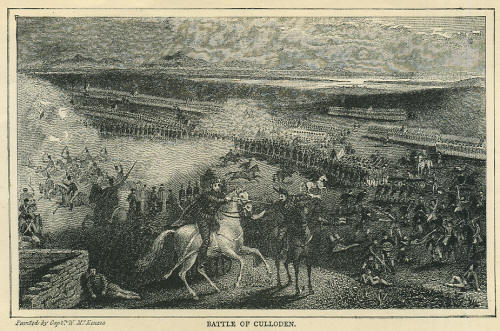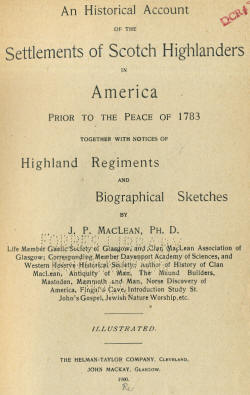|

 To To
Colonel SIR FITZROY DONALD MACLEAN, Bart., C.
B.,
President of The Highland Society of London,
An hereditary Chief, honored by his
Clansmen at home and abroad, on account of the kindly interest he takes in
their welfare, as well as everything that relates to the Highlands, and
though deprived of an ancient patrimony, his virtues and patriotism have
done honor to the Gael, this Volume is
Respectfully dedicated by the
AUTHOR.
"There’s sighing and sobbing in yon Highland forest;
There’s weeping and walling in yon Highland vale,
And fitfully flashes a gleam from the ashes
Of the tenantless hearth in the home of the Gael.
There’s a ship on the sea, and her white sails she’s spreadin’,
A’ ready to speed to a far distant shore;
She may rome hame again wi’ the yellow gowd laden,
But the sons of Glendarra shall come back no more.
The gowan may spring by the clear-rinnin’ burnie,
The cushat may coo in the green woods again.
The deer o’ the mountain may drink at the fountuin,
Unfettered and free as the wave on the main;
But the pibroch they played o’er the sweet blooming heather
Is hushed in the sound of the ocean’s wild roar;
The song and the dance they hae vanish’d thegither,
For the maids o’ Glendarra shall come back no more."
Preface
An attempt is here made to present a field that has not
been preoccupied. The student of American history has noticed allusions to
certain Scotch Highland settlements prior to the Revolution, without any
attempt at either an account or origin of the same. In a measure the
publication of certain state papers and colonial records, as well as an
occasional memoir by an historical society have revived what had been
overlooked. These settlements form a very important and interesting place
in the early history of our country. While they may not have occupied a
very prominent or pronounced position, yet their exertions in subduing the
wilderness, their activity in the Revolution, and the wide influence
exercised by the descendants of these hardy pioneers, should, long since,
have brought their history and achievements into notice.
The settlement in North Carolina, embracing a wide
extent of territory, and the people numbered by the thousands, should, ere
this, have found a competent exponent. But it exists more as a tradition
than an actual colony. The Highlanders in Georgia more than acted their
part against Spanish encroachments, yet survived all the vicissitudes of
their exposed position. The stay of the Highlanders on the Mohawk was very
brief, yet their flight into Canada and final settlement at Glengarry
forms a very strange episode in the history of New York. The heartless
treatment of the colony of Lachlan Campbell by the governor of the
province of New York, and their long delayed recompense stands without a
parallel, and is so strange and fanciful, that long since it should have
excited the poet or novelist. The settlements in Nova Scotia and Prince
Edwards Island, although scarcely commenced at the breaking out of the
Revolution, are more important in later events than those chronicled in
this volume.
The chapters on the
Highlands, the Scotch-Irish, and the
Darien scheme, have sufficient connection to warrant their insertion.
It is a noticeable fact that notwithstanding the
valuable services rendered hy the Highland regiments in the French and
Indian war, but little account has been taken by writers, except in
Scotland, although General David Stewart of Garth, as early as 1822,
clearly paved the way. Unfortunately, his works, as well as those who have
followed him, are comparatively unknown on this side the Atlantic,
I was led to the searching out of this phase of our
history, not only by the occasional allusions, but specially from reading
works devoted to other nationalities engaged in the Revolution. Their
achievements were fully set forth and their praises sung. Why should not
the oppressed Gael, who sought the forests of the New World, struggled in
the wilderness, and battled against foes, also be placed in his true light
If properly known, the artist would have a subject for his pencil, the
poet a picture for his praises and the novelist a strong background for
his romance.
Cleveland, O., October, 1898
Table of Contents
Chapter 1
The Highlanders of Scotland
Chapter 2
The Scotch-Irish in America
Chapter 3
Causes that led to Emigration
Chapter 4
Darien Scheme
Chapter 5
Highlanders in North Carolina
Chapter 6
Highlanders in Georgia
Chapter 7
Captain Lachlan Campbell's New York Colony
Chapter 8
Highland Settlement on the Mohawk
Chapter 9
Glenaladale Highlanders of Prince Edward Island
Chapter 10
Highland Settlement in Pictou, Nova Scotia
Chapter 11
First Highland Regiments in America
Chapter 12
Scotch Hostility towards America
Chapter 13
Highland Regiments in American Revolution
Chapter 14
Distinguished Highlanders who served in America in the interest of Great
Britain
Chapter 15
Distinguished Highlanders in American Interests
Appendix |

